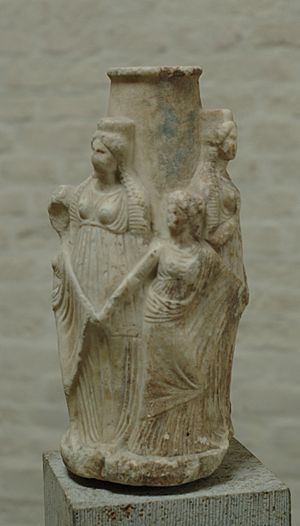Greek underworld facts for kids

The underworld is a special place in Greek mythology. It's where people were believed to go after they died. It's also known as Hades, named after the god who rules this mysterious realm. The entrance to the underworld is guarded by a fierce, three-headed dog named Cerberus.
Ancient Greeks strongly believed in life after death. They thought that when someone died, their soul continued to exist. However, they often saw this afterlife as a shadowy place, not always full of joy or power. Even though a person's identity remained, their soul didn't have much strength or influence in the underworld.
There were different areas where souls could end up. Most people who lived ordinary lives went to the Asphodel Meadows. Heroes and very good people went to the Elysian Fields. People who had been very bad were sent to the Fields of Punishment, or even deeper into Tartarus. If you reached Elysium, you could choose to be reborn. If you made it to Elysium three times, you could go to the Isle of the Blessed. This was like the ultimate paradise or heaven.
Contents
Getting to the Underworld
People who died could enter the underworld in a few ways. One common idea was that a ferryman named Charon would take them across a river. Even though Charon isn't in the very oldest stories, people believed that if a body wasn't properly buried, its soul couldn't cross the river. Another way was for the god Hermes, known as Hermes Psychopompos, to guide the dead to the underworld. This idea appears in Homer's famous story, the Odyssey.
Rivers of the Underworld
In Greek myths, several rivers flow through or around the underworld. Each river has a special meaning.
- The Styx is the most famous underworld river. It's mentioned in Homer's Iliad. Often, Charon the ferryman would row the dead across the Styx to enter the underworld. It's also called the river of hatred.
- The Acheron is known as the river of misery or sorrow. It appears in many old poems, though not as often as the Styx. Sometimes, Charon is said to cross the dead over the Acheron instead of the Styx. In some stories, Acheron is a lake, and its name can even mean the underworld itself.
- The Pyriphlegethon or Phlegethon is the river of blazing fire. Its name means "blazing like fire." Homer's Odyssey mentions it flowing into the Acheron. Later, the philosopher Plato wrote that this fiery river leads to the deep pit of Tartarus and is linked to punishment.
- The Cocytus is the river of wailing or weeping. It's also mentioned in Homer's Odyssey as a branch of the Styx that flows into the Acheron. Plato described the Cocytus as a circular river that empties into Tartarus, where murderers might be punished.
- The Lethe is the river of forgetfulness. It's named after Lethe, the goddess of forgetting. In later myths, a branch from a poplar tree dripping with Lethe's water became a symbol for Hypnos, the god of sleep. Some stories talk about a plain of Lethe instead of a river. Souls that were going to be reborn had to drink from this river. This made them forget their past life and their time in the underworld. Only after drinking could a soul be reborn into the living world.
- Oceanus is a huge river that circles the entire world. It was seen as the boundary between the land of the living and the underworld.
Tartarus: The Deepest Pit
In some Greek stories, Tartarus is just another name for the underworld. But in others, it's a completely separate and much deeper place. The poet Hesiod famously said that Tartarus is as far below the underworld as the Earth is below the sky. Like Hades, it's incredibly dark, so dark that "night is poured around it in three rows."
The most famous prisoners in Tartarus are the Titans. Zeus threw the Titans and his father Cronus into Tartarus after he defeated them in a great war. The poet Homer even wrote that Cronus became the king of Tartarus. According to Plato's dialogue Gorgias (around 400 BC), souls were judged after death. Tartarus was where very wicked people received their divine punishment.
Asphodel Meadows: For Most Souls
The Asphodel Meadows was the part of the underworld where most people's souls went after they died. It was a place for those who hadn't been especially good or bad in life.
Elysium: The Heroes' Paradise
The Elysium, also called the Elysian Fields, was a special place for truly distinguished people. Righteous souls could be sent to the Elysian Fields after being judged by the underworld judges, Rhadamanthus and Minos. Elysium was described as being at the very edges of the world, where life was "easiest for men."
Elysium was also known as the Fortunate Isles or the Isles of the Blessed. These islands were sometimes thought of as a real place on Earth. But they also became known as a place of great reward in the underworld for those who were judged to be exceptionally pure and good.
See also
 In Spanish: Inframundo griego para niños
In Spanish: Inframundo griego para niños


